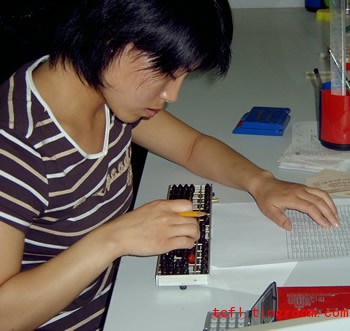____________
Anatomy & Construction
The standard abacus can be used to perform addition, subtraction, division and multiplication; the abacus can also be used to extract square-roots and cubic roots.
The abacus is typically constructed of various types of hardwoods and comes in varying sizes. The frame of the abacus has a series of vertical rods on which a number of wooden beads are allowed to slide freely. A horizontal beam separates the frame into two sections, known as the upper deck and the lower deck.
______________
Basics
The abacus is prepared for use by placing it flat on a table or one’s lap and pushing all the beads on both the upper and lower decks away from the beam. The beads are manipulated with either the index finger or the thumb of one hand.
______________
Bead Values
Each bead in the upper deck has a value of 5; each bead in the lower deck has a value of 1. Beads are considered counted, when moved towards the beam that separates the two decks.
______________
Counting
After 5 beads are counted in the lower deck, the result is “carried” to the upper deck; after both beads in the upper deck are counted, the result (10) is then carried to the left-most adjacent column. The right-most column is the ones column; the next adjacent to the left is the tens column; the next adjacent to the left is the hundreds column, and so on. Floating point calculations are performed by designating a space between 2 columns as the decimal-point and all the rows to the right of that space represent fractional portions while all the rows to the left represent whole number digits.
Technique
Proper finger technique is paramount in achieving proficiency on the abacus. With a Chinese abacus, the thumb and the index finger together with the middle finger are used to manipulate the beads. Beads in lower deck are moved up with the thumb and down with the index finger. In certain calculations, the middle finger is used to move beads in the upper deck.
The Abacus Today: A student from a vocatioanl college in Beijing, China practises using the abacus to settle accounts (a required course for accounting).
The Abacus Today
The abacus is still in use today by shopkeepers in Asia and “Chinatowns” in North America. The use of the abacus is still taught in Asian schools, and some few schools in the West. Blind children are taught to use the abacus wher their sighted counterparts would be taught to use paper and pencil to perform calculations.
One particular use for the abacus is teaching children simple mathematics and especially multiplication; the abacus is an excellent substitute for rote memorization of multiplication tables, a particularily detestable task for young children. The abacus is also an excellent tool for teaching other base numbering systems since it easily adapts itself to any base.
The enduring interest in this ancient device is evident by ever increasing number of visitors to these pages from all around the world.
__________________
Interesting expressions related to the abacus
打算盘 dǎ suànpán, literally means play the abacus (well or badly), when you calculate with the abacus, you will count the numbers (for the cost of money) very carefully to avoid any mistakes. This phrase is often used in spoken language to negatively mean that one is parsimonious (save one’s own money and spend other’s), or thinking only from the good side and failure in spite of efforts. E.G.:
1. You always send me instant messages on the mobile phone and ask me to call you back at once. Aha, 你真会打算盘 nǐ zhēn huì dǎ suànpan (you are playing the abacus so well) !
2. Internatonal community say no to Beijing Olympic Games boycott as a protest against its policy on the Darfur issue. People who harbor such attempts 打错了算盘 dǎ c uò le suànpán (playing the abacus so badly) and they are doomed to fail!




